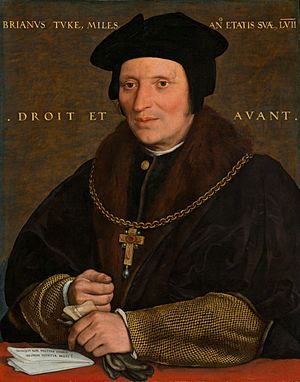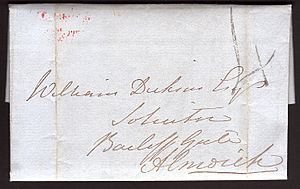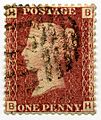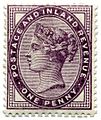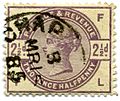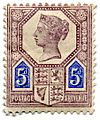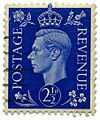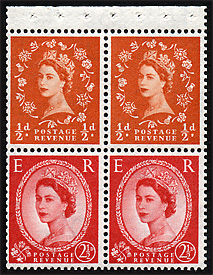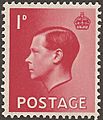Postage stamps and postal history of Great Britain facts for kids

The history of postage stamps and mail in Great Britain tells the story of how letters have been sent in the United Kingdom. It also covers the postage stamps that Great Britain and its past territories have used.
Great Britain's postal history is very important for two main reasons. First, it was the first country to introduce postage stamps in 1840. Second, it built a strong mail system across the British Empire. This system helped create many national postal services we still use today.
Contents
How Mail Started in Britain
The story of mail in Britain began in the 1100s. King Henry I hired special messengers to carry letters for the government. Between 1100 and 1135, these messengers carried about 4,500 letters! Back then, regular people had to find their own ways to send messages.
Later, King Henry III gave uniforms to these messengers. King Edward I set up "posting houses." These were places where messengers could stop and change horses. Under King Edward II, people started writing "Haste, post haste" on letters. This meant the letter needed to be delivered very quickly.
In 1516, King Henry VIII created the Royal Mail. He appointed Brian Tuke as the first "Master of the Postes." Later, Queen Elizabeth I chose Thomas Randolph for the job.
Under Thomas Witherings, the Royal Mail became available to everyone in 1635. It had regular mail routes, post houses, and staff. For a long time, the person receiving the letter usually paid for the postage. But sometimes, the sender could pay when they sent it.
In 1661, King Charles II made Henry Bishop the first Postmaster General. People complained about slow letters. So, Bishop created the Bishop mark. This was a small circle with the month and day inside. It was stamped on letters in London, Edinburgh, and Dublin. Over the years, the postal system grew across the country. Many towns got their own post offices and postmarks.
In 1680, William Dockwra started the London Penny Post. This service delivered letters and small packages within London for just one penny.
Postage Stamps and Big Changes
The "Great Post Office Reform" happened in 1839 and 1840. Rowland Hill led these changes. He is often called the inventor of the postage stamp. He wanted to fix the Post Office's money problems. Hill convinced Parliament to try the Uniform Fourpenny Post. This meant sending a letter cost 4 pence, no matter how far it went.
This new rate started on December 5, 1839. It worked well, but only lasted 36 days. Then, on January 10, 1840, the Uniform Penny Post began. Now, a letter cost only 1 penny if the sender paid. If the person receiving the letter paid, it cost 2 pence. These simple, fixed prices made it easy to use a small "adhesive label" to show postage was paid.
So, on May 6, 1840, the Penny Black stamp was first used. It was the world's very first postage stamp!
Rowland Hill received over 2,000 ideas for the stamp. He chose Perkins, Bacon & Petch, a company that printed banknotes. They used a special printing method called steel engraving. The image of Queen Victoria on the stamp came from a medal made by William Wyon.
The Penny Black was first used only within the United Kingdom of Great Britain and Ireland. Because of this, the country's name was not on the stamp. Other countries agreed to this, as long as the Queen's picture was on the stamp. Envelopes that already had postage paid *did* have the country's name. In 1951, a special stamp for the Festival of Britain included the word "Britain." This was one of the first times the country's name appeared on a UK stamp.
After the Penny Black was used, people realized black was not a good color. The ink used to cancel the stamp was hard to see on black. So, from 1841, stamps were printed in a brick-red color. These Penny Red stamps were used for many decades. About 21 billion of them were made!
Victorian Era Stamps
The Victorian age (when Queen Victoria ruled) brought many new ideas for stamps. It was hard to cut stamps from a sheet with scissors. So, people tried new ways to separate them, like rouletting (the Archer Roulette). Then, perforation was invented, which made tiny holes between stamps. This became the normal way to separate stamps in 1854.
In 1847, the first British embossed postage stamps were made. These were 1 shilling stamps. Then came 10 pence stamps the next year, and 6 pence stamps in 1854.
Surface-printed stamps first appeared in 1855. A 4 pence stamp was printed by De La Rue. This type of printing soon became the standard. In 1870, ½d (halfpenny) and 1½d (penny halfpenny) stamps were made using engraving. These were the last engraved stamps of Queen Victoria for a long time. Surface-printed stamps from the 1860s and 1870s all showed the same side profile of Victoria. But they had different frames, watermarks, and letters in the corners.
Higher value stamps also appeared. A 5 shilling stamp came out in 1867. Then came 10 shilling and £1 stamps in 1878. Finally, a £5 stamp was issued in 1882.
The Penny Red stamps were eventually stopped. New low-value stamps were also surface-printed. The first was a 1 penny stamp in a square frame, colored "Venetian red," issued in 1880. However, a new law in 1881 meant stamps also had to work as tax stamps. So, the Penny Lilac was issued. It said "POSTAGE AND INLAND REVENUE." This stamp became the main letter stamp for the rest of Victoria's reign. Huge numbers of them were printed. Later stamps said "POSTAGE & REVENUE," which became "POSTAGE REVENUE."
In 1883 and 1884, stamps were made with special inks that would fade. These were the "Lilac and Green Issue." They had simple designs, with low values in lilac and high values in green. The colors were chosen because they were the only ones available. These stamps did fade when soaked, so not many survived. But people did not like their plain look.
The last big stamp series for Victoria was the "Jubilee issue" of 1887. It had twelve designs, from ½d to 1 shilling. Most were printed in two colors or on colored paper. These stamps were not made specifically for the Jubilee (a celebration of 50 years on the throne), but they were issued during that time.
Early 1900s Stamps
When King Edward VII became king, new stamps were needed. The designs were quite traditional. Most of the old "Jubilee" frames were used again. The King's picture was still a single side profile. Edward's time as king was short, so there were no big changes in stamp design. During this time, a new type of paper called chalk-surfaced paper was used. You can tell if paper is chalk-surfaced by rubbing silver on it; it will leave a black mark.
In contrast, the stamps of King George V were new and different from the start. The first stamps were ½d and 1d values, in the same colors as before. The main design still had the King's picture in an oval, with a fancy frame and a crown. But for the first time, a three-quarter portrait of the King was used. However, later designs went back to the standard side profile.
The UK's first commemorative stamps were made for the British Empire Exhibition in 1924. These two large stamps showed a powerful lion. They were issued twice, in 1924 and 1925, with the year printed on them. A second set of commemorative stamps came out in 1929. These marked the 9th Congress of the Universal Postal Union (UPU), which was held in London that year.
Irish Free State Becomes Independent
After the Anglo-Irish Treaty in 1921, the new Irish government took over postal services. When the Irish Free State became fully independent in December 1922, they appointed their own Postmaster General. Later, this job became the Minister for Posts and Telegraphs in 1924.
One clear sign of this change was that all post boxes in Ireland were painted green instead of red. Also, British postage stamps were overprinted with "Saorstát Éireann 1922" (Irish Free State 1922) before Ireland issued its own stamps.
-
An Irish Free State stamp with "Saorstát Éireann 1922" printed over a 2/6 King George V stamp.
-
A green painted Edward VII pillar box in Rosslare Harbour, Ireland.
Kings, Abdication, and War
In 1936, four stamps were issued for King Edward VIII before he gave up his throne. King George VI's coronation was celebrated with a special stamp. This stamp was part of a larger set issued across the British Empire. New regular stamps showed a picture of the King on a solid colored background. This design was based on a sculpture by Edmund Dulac. It was similar to the Machin stamps that would come out 30 years later.
In 1940, the 100th birthday of the postage stamp was celebrated. Six stamps were issued, showing Queen Victoria and King George VI together. By 1941, World War II affected stamp printing. The 1937 stamps were printed with less ink, making them much lighter in color. After the war, stamps were issued to celebrate peace, the Silver Jubilee (25 years on the throne) and the 1948 Summer Olympics in 1948. Another stamp marked the 75th anniversary of the UPU in 1949.
In 1950, the colors of all the low-value stamps were changed. In 1951, a new series of high-value stamps (2s 6d, 5s, 10s, £1) came out. Two commemorative stamps were also issued for the Festival of Britain.
Modern Stamps
When Queen Elizabeth II became queen in 1952, new stamps were needed. A series of stamps known as the Wilding issues were created. They were based on a photo of the Queen by Dorothy Wilding.
Wilding stamps were used until 1967. On June 5, the Machin issues were introduced. The Machin design is very simple: a side profile of the Queen on a solid colored background. This design is very popular and is still the standard British stamp today. They have been printed in many different colors. When Britain changed to decimal money, new stamp values were needed. Also, printing methods have improved. All these changes mean there are hundreds of different Machin stamp types for collectors!
Today, postage stamps are used in many countries. Many former British colonies once used stamps with Queen Victoria's picture, like Barbados, Fiji, and India. Many former colonies still show Queen Elizabeth's picture. But some now feature local scenery, birds, or animals on their stamps.
How British Stamp Designs Changed
Until the 1950s, Britain did not issue many commemorative stamps. Most stamps were regular issues that mainly showed the reigning monarch's portrait. Even when commemorative stamps became more common in the 1950s and early 1960s, the monarch's picture was still very big. It often took up a quarter or a third of the stamp design. This made it hard for designers to be creative.
A big change happened in 1965. The Postmaster General, Tony Benn, set new rules for stamp designs. Designer David Gentleman suggested replacing the monarch's head with another national symbol, like a crown or the country's name. A compromise was reached: a small outline of the Queen's head. This small outline is based on a coin design by Mary Gillick. This small silhouette has been the standard for commemorative stamps ever since. If the Queen's portrait is already part of the main stamp design (like for her birthday stamps), then the silhouette is not needed.
Another trend is using stamps to celebrate events related to the Royal Family. Before Queen Elizabeth II became queen in 1952, royal event stamps were rare. There were stamps for King George V's Silver Jubilee in 1935, King George VI's coronation in 1937, and his 25th wedding anniversary in 1948. But since 1952, many stamps have been issued for royal occasions. Also, memorial stamps have been issued after the deaths of Diana, Princess of Wales (in 1998) and Queen Elizabeth The Queen Mother (in 2002).
Stamps have also honored past monarchs. In 1987, stamps marked 150 years since Queen Victoria became queen. In 1997, stamps marked 450 years since King Henry VIII died. From 2008 to 2011, stamps were issued featuring all of England's kings and queens, and also the Scottish House of Stewart.
British Mail Services Around the World
The United Kingdom has set up mail services in many countries around the world. Often, they used British stamps that had special local overprints (extra printing on top).
Images for kids
-
An Irish Free State stamp with "Saorstát Éireann 1922" printed over a 2s 6d King George V stamp.
-
A green painted Edward VII pillar box in Rosslare Harbour, Ireland.
See also
 In Spanish: Historia postal del Reino Unido para niños
In Spanish: Historia postal del Reino Unido para niños


